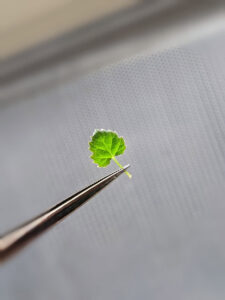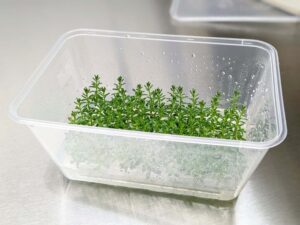
An insight into plant tissue culture
By Lisa Wightwick
Many members of our industry would have encountered ‘tissue culture’ or ‘TC’ at least once in the course of their careers. I’m usually met with fascination when I tell people I work in plant tissue culture, due, in part, to the mysterious and technical reputation the field seems to have garnered.
So, what is tissue culture? The term ‘tissue culture’ can actually refer to either the culture of plant or animal matter. Plant tissue culture (PTC) is the in vitro (in glass in Latin) growth of plant cells, tissues and organs in a sterile environment. Chief factors in the plant’s survival – light, water, nutrition, heat, and humidity are provided externally, creating a fully-controlled environment in which plant growth can be established and influenced. Typical tissue culture operations are carried out in laboratories equipped with specialised equipment including light and temperature-controlled growth areas, sterilising appliances, and transfer chambers.

PTC begins with the harvesting of plant parts (explants) which are rigorously sterilised and conditioned to the in vitro environment. In lieu of soil or other substrates, the explants are placed in a cocktail of water, macro and micronutrients, growth regulators, a carbohydrate source, vitamins, and a gelling agent to hold it all together. After a time on this jelly-like media, the explants will shift into a state of juvenility through the development of very small seedling-like shoots. These shoots can be excised, multiplied, and compelled to root, facilitating reintroduction to the outside environment – major steps in the cycle of micropropagation.

Micropropagation utilises plant tissue culture methods to mass produce virtually any plant species, year round. The commercialisation of micropropagation is widespread, with many laboratories operating to supply propagation nurseries with tissue culture plant stock. Species that are difficult to propagate by traditional methods may be easier or more efficient through culture. Other advantages of micropropagation include virus- and disease-free stock, clonal propagation of plants with ideal traits, and non-seasonal production.
Many out there would be most familiar with micropropagation, many likely having purchased and/or handled tissue-cultured plants, but other intriguing applications of PTC are developing, serving the advancement of horticulture, agriculture, genetics, and biotechnology. Notable fields applying plant tissue culture techniques include:
- improvement of disease, virus, insect, and stress resistance in plants
- increasing crop yields (genome editing)
- synthetic seed production and preservation
- conservation of rare and endangered plant species
- molecular farming/pharming
‘Molecular farming’ is a particularly interesting field where PTC can be used to produce various secondary metabolite products. Secondary metabolites are produced by plants to aid in survival under stress. The metabolites are valued in many different industries such as pharmaceuticals, food and beverages, textiles, and agriculture. Some familiar examples include food additives like sweeteners, vanillin and capsaicin, and medicines such as morphine and codeine. In some cases, conventional means of farming these metabolites are not viable due to environmental conditions, pests, diseases, and slow plant growth. Moving this production to an in vitro laboratory setting negates many of these issues. Specialised plant tissue culture innovations, like temporary immersion bioreactors (a liquid culture system), are used to grow plants from which these metabolites can be sourced. Signalling molecules can also be used to enhance yields by initiating plant defence mechanisms, stimulating the over-production of the metabolites.
Sustainability is increasingly becoming a focal point of the horticulture industry, but it’s something I’ve never heard mention of regarding micropropagation. So, is commercialised micropropagation sustainable? Commercial laboratories already have the green advantage of being able to produce and house tens of thousands of plants in an area the size of an average bedroom. That ability to mass-produce tissue culture plants equals more plants in the ground, thus improving the environment. The one weak point of plant tissue culture is the waste that it can produce through the need for sterility. COVID19 was an eye-opener to how much waste can be generated by single-use items such as test kits, masks, and gloves. PTC laboratories can be similar in this aspect – many of the processes and tools require sterility and best practice stipulates single use to avoid cross-contamination.

One of the greatest waste contributors in commercial laboratories can be the type of vessel the plants are grown in. The most common types of culture vessels are specialised glass jars and plastic takeaway containers. Both have their advantages and disadvantages – glass containers are indefinitely reusable, but use a high labour, water, and power cost to wash and sterilise, and are better suited for smaller operations. While the idea of glass culture vessels sounds great on paper, incorporating them into a large-scale commercial laboratory may be too costly in labour and other resources, considering some laboratories can hold thousands of culture vessels. Plastic containers are much more readily available in bulk and are cheaper to use in a commercial setting, but unfortunately are usually single-use.
At a tour of the Garden City Plastics and Polymer Processors in June of 2022, I was introduced to the PP5 recycling initiative. Pots, trays and labels that are marked with ‘PP5’ (polypropylene plastic) can be collected, recycled and manufactured into new products. After this tour, I went back to work and was happy to find that the containers used in the laboratory were, in fact, PP5 plastic. It’s now part of our standard process that when a culture container must be disposed of, it’s emptied of its contents, stacked with others, and placed in the PP5 collection cage provided to our nursery. I already work to minimise the number of containers being thrown out but being able to recycle them helps further decrease the carbon footprint of the laboratory. It’s possible to balance efficiency and sustainability; it just takes some lateral thinking and enthusiasm.
Lisa Wightwick,
Plant Tissue Culture &
Micropropagation Specialist
Peninsula Growers
